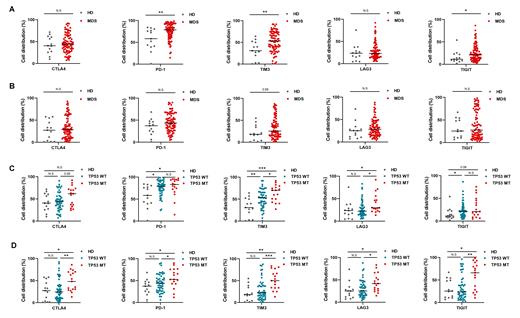Background
TP53 mutations were common in MDS patients and associated with adverse prognosis. The pathogenetic mechaminsms of TP53 mutations in MDS were complicated. Recently, TP53mutations were found to confer an immunosuppressive phenotype in MDS and AML. However, the expressions of checkpoint receptors in T cells subsets of MDS patients with TP53 mutations is unclear.
Methods
Between December 2021 to May 2023, fresh bone marrow mononuclear cells (BM-MNCs) were obtained from 82 de novo MDS patients and 13 healthy donors, and isolated using Ficoll. Then, flow cytometry was performed on BM-MNCs to evaluate the expressions of checkpoint receptors (CTLA4, PD-1, TIM3, LAG3 and TIGIT) in T cells subsets including all T cells (CD3 +), helper T cells (CD3 +, CD4 +), and cytotoxic T cells (CD3 +, CD8 +). TP53 mutations were examined in 67 patients who simultaneously accepted NGS examinations. The differences of the expression of checkpoint receptors in T-cells subsets were assessed by Mann-Whitney U test. Significance was defined as P < 0.05.
Results
We firstly compared the expressions of checkpoint receptors in T cells subsets of MDS patients with healthy donors. In the whole T cells, MDS patients had increased frequencies of PD-1 + cells (P < 0.05), and TIM-3 + cells (P < 0.05) compared with healthy donors. As for helper T cells subset (Figure 1A), the percentages of PD-1 + cells (P<0.01), TIM-3 + cells (P<0.01), and TIGIT + cells (P<0.05) in MDS patients were higher than healthy donors, while no significant differences of the percentages of CTLA4 + cells or LAG3 + cells were observed between MDS patients and healthy donors. While only considering cytotoxic T cells (Figure 1B), the percentages of CTLA4 + cells, PD-1 + cells, TIM-3 + cells, LAG3 + cell, and TIGIT + cells in MDS patients were as similar as those in healthy donors.
Next, we compared the expressions of checkpoint receptors in T-cells subsets between TP53-mutated MDS patients (N=17) and TP53wild-type MDS patients (N=50). Among all T cells, significantly increased frequencies of CTLA4 + cells (P<0.01), PD-1 + cells (P<0.05), TIM-3 + cells (P<0.01), and LAG3 + cells (P<0.01) were found in TP53-mutated MDS patients compared with TP53 wild-type MDS patients. In helper T cells subset (Figure 1C), TP53-mutated MDS patients possessed increased frequencies of TIM-3 + cells (P<0.05) and LAG3 + cells (P<0.05) than TP53 wild-type MDS patients. But the frequencies of CTLA4 + cells, PD-1 + cells and TIGIT + cells in helper T cells of TP53-mutated MDS patients were as similar as those in TP53 wild-type MDS patients. When focusing on cytotoxic T cells (Figure 1D), the percentages of CTLA4 + cells (P<0.01), PD-1 + cells (P<0.05), TIM-3 + cells (P<0.001), LAG3 + cell (P<0.05), and TIGIT + cells (P<0.01) were all significantly greater in TP53-mutated MDS patients than those in TP53 wild-type MDS patients. Also, the frequencies of CTLA4 + cells (P<0.05), PD-1 + cells (P<0.05), TIM-3 + cells (P<0.01), LAG3 + cell (P<0.05), and TIGIT + cells (P<0.05) in cytotoxic T cells of TP53-mutated MDS patients were higher than those in healthy donor (Figure 1D).
Conclusion
Collectively, the percentages of PD-1 + cells, TIM-3 + cells, and TIGIT + cells in helper T cells subset of MDS patients were higher than those in normal people, while the expressions of checkpoint receptors in cytotoxic T cells of MDS patients had no significant difference compared with those in healthy donors. However, when considering TP53mutation status, the frequencies of CTLA4 + cells, PD-1 + cells, TIM-3 + cells, LAG3 + cell, and TIGIT + cells in cytotoxic T cells of TP53-mutated MDS patients were all significantly higher than those in TP53 wild-type MDS patients or healthy donors. These results indicated T cells exhaustion and immunosuppressive microenvironment existing in MDS especially those with TP53mutations, and suggested that immunomodulatory therapeutic strategies targeting checkpoint receptors may be beneficial for MDS especially those with TP53mutations.
Disclosures
No relevant conflicts of interest to declare.


This feature is available to Subscribers Only
Sign In or Create an Account Close Modal